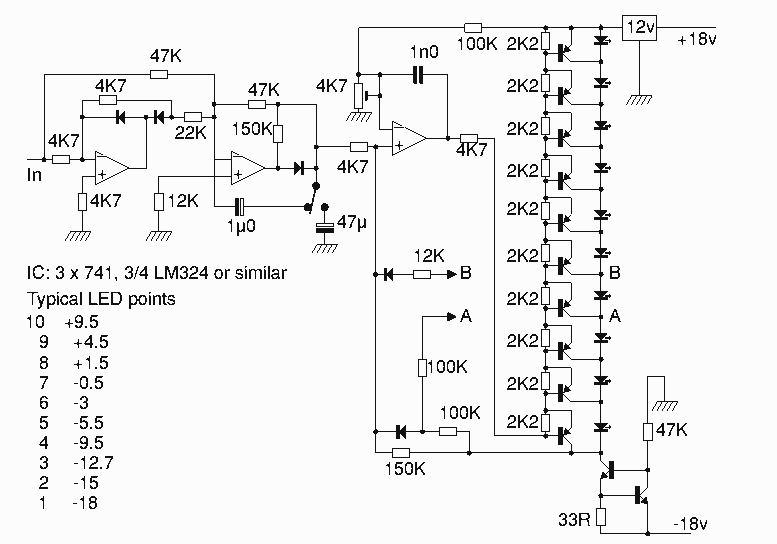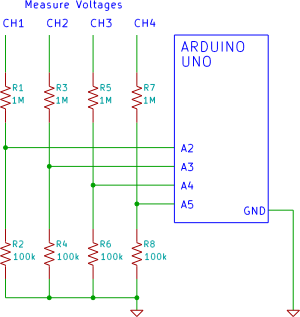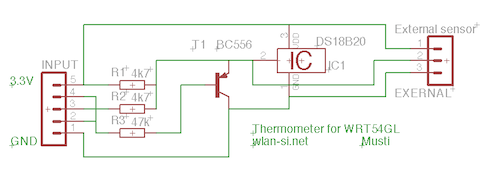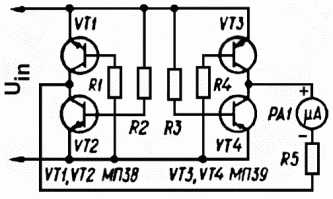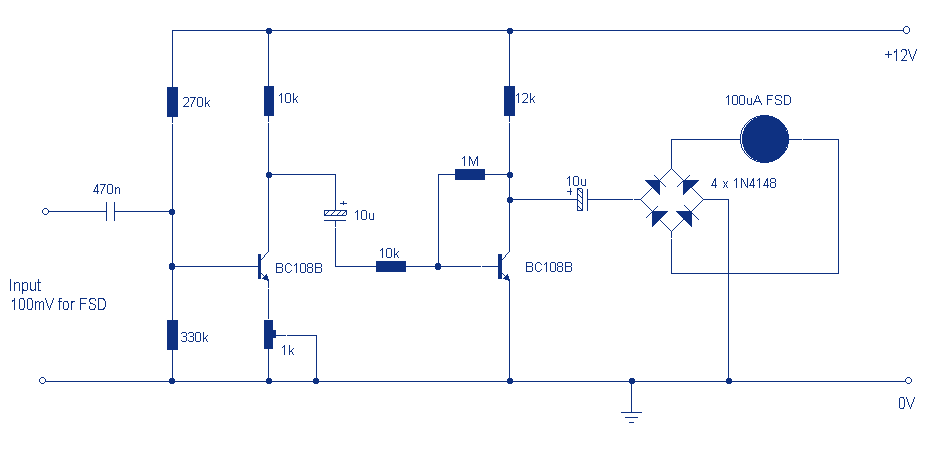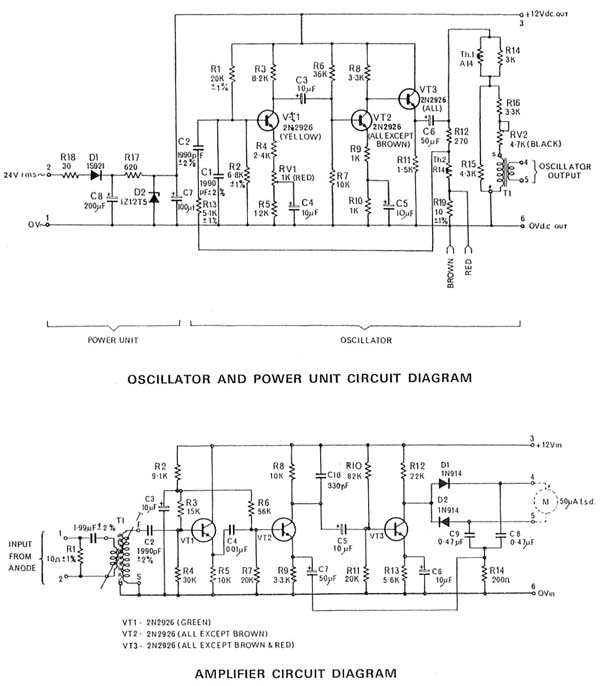
PC Temperature Meter
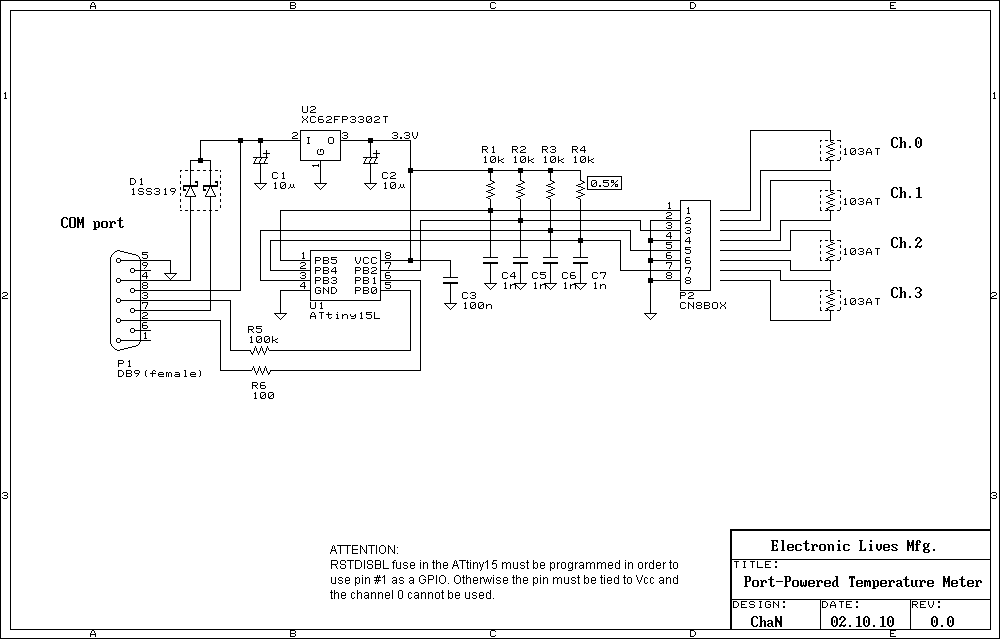
This is a four-channel temperature measurement adapter that works without an external power supply. It is suitable for measuring temperature and logging its data with a PC. The circuit diagram is very simple and no adjustment is required; everybody will be able to build it with ease. An Atmel ATtiny15L is chosen for this project. It is the only device that has a built-in 10-bit A-D converter in the 8-pin AVRs. The A-D converter has a bandgap reference and differential amplifier as its front-end. The AVR core is clocked by only an internal RC oscillator (calibrated to 1.6 MHz); any other clock source cannot be used. A 25.6 MHz clock source that is 16x multiplied from the core clock is available for the timer/counter. This means that a fast PWM output can be generated. Therefore, the ATtiny15L has good analog I/O capability. The devices that work on the COM port without an external power supply, such as serial mice, are powered from the COM port. When an application program opens the COM port, ER and RS signals will go high. The high-level voltage is from 6V to 12V at most PCs, and it can supply 5 mA at least. This is sufficient for low-power microcontrollers. Four 103AT precision thermistors are used as temperature sensors. Its variation is very small; its temperature-resistance error at room temperature is ±0.3°C. The error of series resistors should be within ±0.5% to enable a calibration-free design. Sending commands with any program and logging the returned data to a file directly creates a CSV file, which can be read into most spreadsheets. However, if Microsoft Excel is available, it can be used as a data logger without any external program. Microsoft Excel has a subset of Visual Basic called VBA, which can be used as a control program to capture data and log it into the worksheet. The data in the sample worksheet is logged temperature in the refrigerator for a day. The thermostat operation and defrosting operation can be read well from the graph. Alt-F11 opens the built-in Visual Basic Editor. The program might not be readable because it is controlling the COM port and timer with API for portability. No additional components are used; only Excel is required for this example VBA project.
The described four-channel temperature measurement adapter is designed to operate efficiently without requiring an external power supply, utilizing the power provided by the COM port of a PC. The Atmel ATtiny15L microcontroller serves as the core of this design, notable for its integrated 10-bit analog-to-digital converter (ADC) and minimal pin count. This microcontroller is particularly suitable for applications where space and power efficiency are critical.
The ADC features a bandgap reference and a differential amplifier, enhancing its accuracy and stability across temperature variations. The internal RC oscillator, calibrated to 1.6 MHz, provides the necessary clock signal for the microcontroller's operations, while the option for a 25.6 MHz timer/counter clock allows for generating fast PWM signals, which can be advantageous for controlling peripherals or managing timing-sensitive tasks.
Temperature sensing is accomplished through the use of four 103AT precision thermistors, which offer a high degree of accuracy with a temperature-resistance error of only ±0.3°C at room temperature. The design ensures that the series resistors maintain an error margin of ±0.5%, facilitating a calibration-free setup that simplifies the assembly process.
Data logging capabilities are integrated into the design, allowing users to send commands via any terminal program that communicates with the COM port. The returned data, which represents temperature readings, can be logged directly into a CSV file, making it compatible with various spreadsheet applications for analysis. Notably, Microsoft Excel can also function as a data logger through its VBA capabilities, enabling automated data capture and logging without the need for additional software.
The logged data can provide valuable insights into temperature fluctuations over time, such as monitoring refrigerator temperatures and analyzing the performance of thermostatic controls and defrost cycles. This practical application exemplifies the potential for simple electronic designs to yield significant benefits in data collection and analysis, reinforcing the versatility of the ATtiny15L in low-power, compact measurement systems.This is a four-channel temperature measurmet adapter that works without external power supply. It will suitable for measureing temperature and logging its data with a PC. The circuit diagram is very simple and no adjustment is required, everybody will able to build it with ease. I chose an Atmel ATtiny15L for this project. It is the only device that has a built-in 10bit A-D converter in the 8 pin AVRs. The A-D converter has a bandgap reference and differencial amplifire as its front-end. The AVR core is clocked by only internal RC oscillator (calibrated to 1.6MHz), any other clock souce cannot be used.
Also 25.6MHz clock source that 16x multiplied from core clock is available for timer/counter. This means that a fast PWM output can be generated. Therefore the ATtiny15L has good analog I/O capabiltity. The devices that works on the COM port without external power supply, such as serial mouse, are powered from the COM port. When an application program opens COM port, ER and RS signals will go high. The high level voltage is from 6V to 12V at most PCs, and it can supply 5mA at least. This is sufficient for low power micro-controllers. Four 103AT precision thermisters are used as temperature sensor. Its variation is very small, its temperature - resistance error at room temperature is ±0.3°C. The error of series resisters should be within ±0.5% to enable calibration-free design. Sending commands with any program and logging the returened data to a file directly creates a CSV file.
It can be read into most spleadsheets. However if you have a Microsoft Excel, it can be used as a data logger without any external program. The Microsoft Excel has a subset of the Visual Basic that called VBA. This can be used as a control program to capture data and log it into the worksheet... it's great! I had not known that the Excel has this feature. This is one of the good solutions of automatic measurement. The data in the sample worksheet is logged temperature in the refregerator for a day. The thermostat operation and defrosting oeration can be read well from the graph. Alt-F11 opens the built-in Visual Basic Editor. The program might not readable because it is controling COM port and timer with API for portability. Any additional component is not used, only an Excel is required for this exsample VBA project. 🔗 External reference
The described four-channel temperature measurement adapter is designed to operate efficiently without requiring an external power supply, utilizing the power provided by the COM port of a PC. The Atmel ATtiny15L microcontroller serves as the core of this design, notable for its integrated 10-bit analog-to-digital converter (ADC) and minimal pin count. This microcontroller is particularly suitable for applications where space and power efficiency are critical.
The ADC features a bandgap reference and a differential amplifier, enhancing its accuracy and stability across temperature variations. The internal RC oscillator, calibrated to 1.6 MHz, provides the necessary clock signal for the microcontroller's operations, while the option for a 25.6 MHz timer/counter clock allows for generating fast PWM signals, which can be advantageous for controlling peripherals or managing timing-sensitive tasks.
Temperature sensing is accomplished through the use of four 103AT precision thermistors, which offer a high degree of accuracy with a temperature-resistance error of only ±0.3°C at room temperature. The design ensures that the series resistors maintain an error margin of ±0.5%, facilitating a calibration-free setup that simplifies the assembly process.
Data logging capabilities are integrated into the design, allowing users to send commands via any terminal program that communicates with the COM port. The returned data, which represents temperature readings, can be logged directly into a CSV file, making it compatible with various spreadsheet applications for analysis. Notably, Microsoft Excel can also function as a data logger through its VBA capabilities, enabling automated data capture and logging without the need for additional software.
The logged data can provide valuable insights into temperature fluctuations over time, such as monitoring refrigerator temperatures and analyzing the performance of thermostatic controls and defrost cycles. This practical application exemplifies the potential for simple electronic designs to yield significant benefits in data collection and analysis, reinforcing the versatility of the ATtiny15L in low-power, compact measurement systems.This is a four-channel temperature measurmet adapter that works without external power supply. It will suitable for measureing temperature and logging its data with a PC. The circuit diagram is very simple and no adjustment is required, everybody will able to build it with ease. I chose an Atmel ATtiny15L for this project. It is the only device that has a built-in 10bit A-D converter in the 8 pin AVRs. The A-D converter has a bandgap reference and differencial amplifire as its front-end. The AVR core is clocked by only internal RC oscillator (calibrated to 1.6MHz), any other clock souce cannot be used.
Also 25.6MHz clock source that 16x multiplied from core clock is available for timer/counter. This means that a fast PWM output can be generated. Therefore the ATtiny15L has good analog I/O capabiltity. The devices that works on the COM port without external power supply, such as serial mouse, are powered from the COM port. When an application program opens COM port, ER and RS signals will go high. The high level voltage is from 6V to 12V at most PCs, and it can supply 5mA at least. This is sufficient for low power micro-controllers. Four 103AT precision thermisters are used as temperature sensor. Its variation is very small, its temperature - resistance error at room temperature is ±0.3°C. The error of series resisters should be within ±0.5% to enable calibration-free design. Sending commands with any program and logging the returened data to a file directly creates a CSV file.
It can be read into most spleadsheets. However if you have a Microsoft Excel, it can be used as a data logger without any external program. The Microsoft Excel has a subset of the Visual Basic that called VBA. This can be used as a control program to capture data and log it into the worksheet... it's great! I had not known that the Excel has this feature. This is one of the good solutions of automatic measurement. The data in the sample worksheet is logged temperature in the refregerator for a day. The thermostat operation and defrosting oeration can be read well from the graph. Alt-F11 opens the built-in Visual Basic Editor. The program might not readable because it is controling COM port and timer with API for portability. Any additional component is not used, only an Excel is required for this exsample VBA project. 🔗 External reference
Warning: include(partials/cookie-banner.php): Failed to open stream: Permission denied in /var/www/html/nextgr/view-circuit.php on line 713
Warning: include(): Failed opening 'partials/cookie-banner.php' for inclusion (include_path='.:/usr/share/php') in /var/www/html/nextgr/view-circuit.php on line 713
